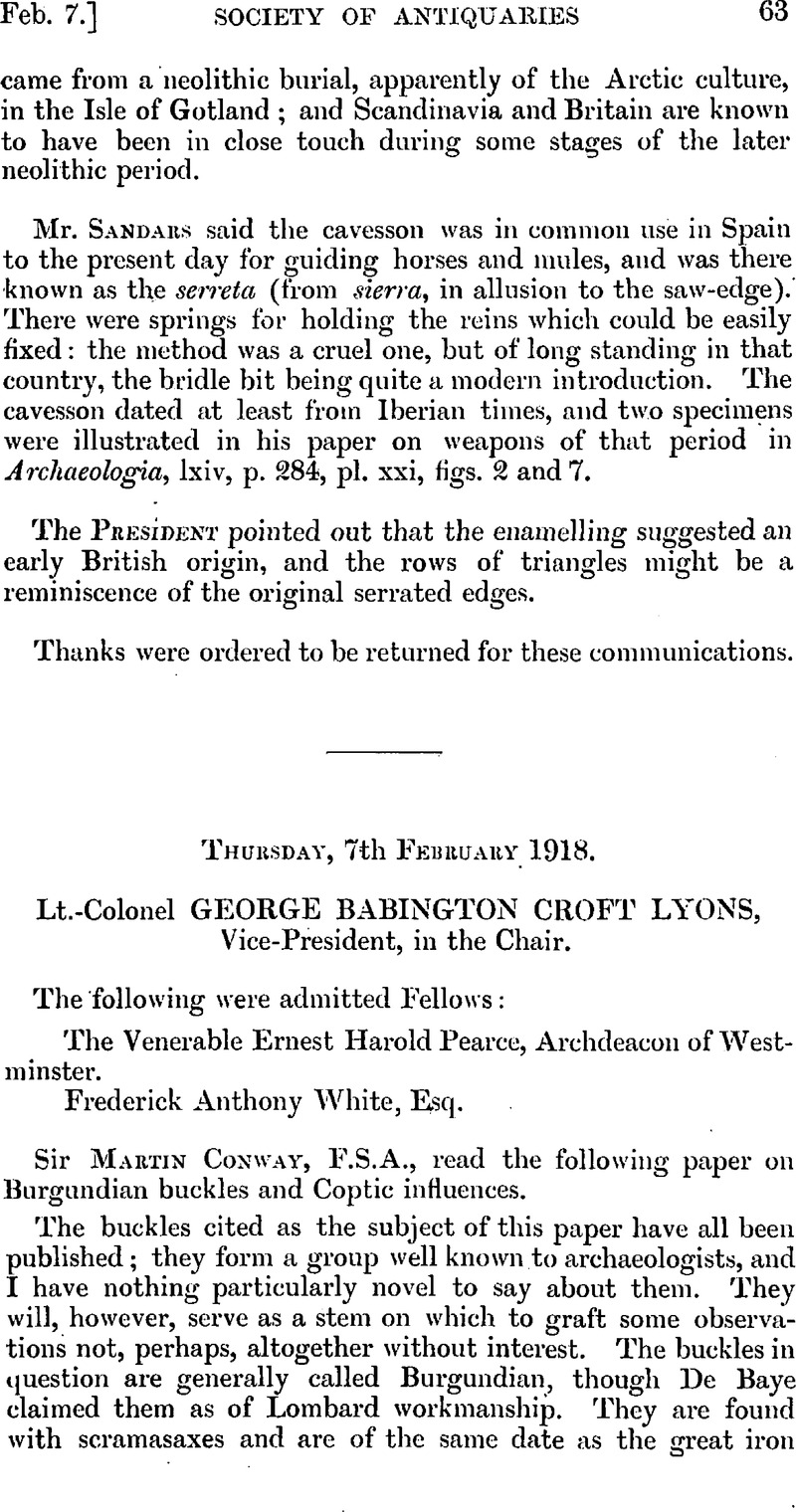Published online by Cambridge University Press: 10 May 2010

page 64 note 1 R. de Fleury, La Messe.
page 64 note 2 Mitt. d. Antiq. Ges, in Zürich, Band 24, pl. iv, fig. 28. Here also is reproduced the plate of another buckle of which there is a cast in the Zürich Museum, with a chalice between two birds as its central ornament. It likewise is inscribed.
page 64 note 3 See R de Fleury, La Messe, vol. vii, pl. 522, p. 28j and references there given.
page 65 note 1 Bull. Soc. d. Antiq. de France, 1877, p. 196 ; Mém. Soc. Antiq. du Centre, vii, p. 243 ; and R. de Fleury, La Messe, vii, pl. 522.
page 65 note 2 See Professor Baldwin Brown in Burlington Magazine, 1913, p. 99.
page 65 note 3 Cattaneo (fig. 26) ascribes it to the seventh century ; R. de Fleury La Messe, i, p. 128, pl. 50) to the sixth ; De Rossi to the fifth. Cattaneo is probably correct.
page 65 note 4 Photograph in Baldwin Brown's Arts of our Teutonic Forefathers.
page 66 note 1 Hawara, etc., pl. 21 and p. 21.
page 67 note 1 R. de Fleury, La Messe, vi, p. 208, pl. 514.
page 67 note 2 The gesture is of pagan origin. ‘In adorando dexteram ad osculum referimus’ (Pliny, Hist. Nat. xviii. 5). It is the ‘geste d' acclamation’ of Cabrol (Dict. i, col. 253).
page 68 note 1 Numerous examples of this type are reproduced in De Baye's Industrie langobarde. They are widely scattered from Normandy to North Italy, but are commonest in the Burgundian regions.
page 70 note 1 A. Haupt; Baukunst der Germanen, pp. 207 and 247.
page 70 note 2 St. Germain Museum, Lausanne Museum from Lavigny. Daniel buckles are commonest in the Canton de Vaud. Examples are known from Daillens (2), Cossonay, Mongiti, Crissier, Ferreyres, and Villars Sainte-Croix. One in Dijon Museum was found in a stone sarcophagus. According to the report of a meeting of the Commission du Vieux Paris (Feb. 8, 1912 or 1913) a Daniel buckle was found in the Quartier St. Marcel and is in the Musée Carnavalet. See also Cabrol's Dictiounaire, iv, col. 235 ff.
page 72 note 1 Also a limestone relief in Berlin K.F.M. (no. 1638) of fifth-sixth century ; a bucket from a Merovingian cemetery at Miaunay near Abbeville. (Mém. Soc. Antiq. de France, t. 35, p. 68) ; a lamp (loc. cit., p. 73) ; a sarcophagus at Aries (Le Blant, pl. 27, fig. 2) ; another at Brescia (Oderici, Mon. inst. de B., pl. 12, fig. 3).
page 72 note 2 2 For a list see Cabrol's Dictionnaire, iv, col. 224; R. de Fleury, La Messe, vi, p. 12, pl. 437.
page 73 note 1 There is a fresco of Daniel and the Lions attributed to the second century in the Cappella Greca. See Studi Romani, i, pl. 16.
page 73 note 2 The attempt to bring this ivory down to the eleventh century cannot be regarded as successful.
page 74 note 1 St. Menas was a popular saint in the south of France. There was an oratory dedicated to him at Arles.
page 75 note 1 Revue de l' Art chrét., 1893, p. 38.
page 75 note 2 Another North African lamp, probably from the same workshop, shows the Ascension treated in rather a similar way. Two angels support Christ's feet and two disciples stand below looking up. It was one of a find of 191 lamps, at Syracuse. See Notiz. degli Scavi, 1915, p. 208 ; Venturi, i, p. 472 ; Amer. Journ. of Archaeol., 1915, p. 277.
page 76 note 1 See Strzygowski, Hell. u. kopt. Kunst, figs. 21, 22. See also Cabrol's Dict. i, col. 1138 ; ii, cols. 511–14; iii, col. 2102. There is a painting of Christ on two beasts in the catacomb of Karmuz, Alexandria. Reprod by Cabrol, i, fig. 286.
page 77 note 1 Other examples from the Canton de Vaud come from Grancy, Cossonay, Attalens, and Ecoublons.
page 77 note 2 Boulanger, mobilier funéraire, pl. 45, fig. 2.
page 78 note 1 There is a cast of this curious buckle in the Zürich Museum. I believe the original is in the museum at Berne.
page 78 note 2 See Mém. Soc. Hist, et Arch, de Genève, t. ix, pl. 1 ; t. xi, p. 81.
page 79 note 1 Rev. archéol. 1879, p. 234 ff.
page 80 note 1 Berlin K.F.M., no. 759 ; Cairo Mus., no. 7015 ; the Cochrane Sale; etc. A single laden camel as a pendant (Berlin K.F.M., no. 740) may have had a like purpose.
page 80 note 2 M.M. Besson of Lausanne, in the Revue Charlemagne and in L'Art barbare (with admirable plates), 1909, noted the Coptic affinities of certain Burgundian designs.
page 80 note 3 Akerman, Pagan Saxondom, pl. 13 ; Baldwin Brown, The Arts in Early England, pl. 114, p. 467.
page 82 note 1 Arts in Early England, pl. 9, p. 103.
page 83 note 1 Baldwin Brown, pl. 16.
page 83 note 2 Berlin, Mus. f. Völkerkunde.
page 83 note 3 Compare Berlin K.F.M., no. 1027 ; Cairo Mus., nos. 7171 and 9102.
page 85 note 1 Bibl. Nat. Paris, lat. 1. Michel, Hist. de l'Art, i. 1, p. 356.
page 88 note 1 Proceedings, xxiii, 489, fig. 6.
page 88 note 2 Antiquary, xlvi (1910), p. 269.